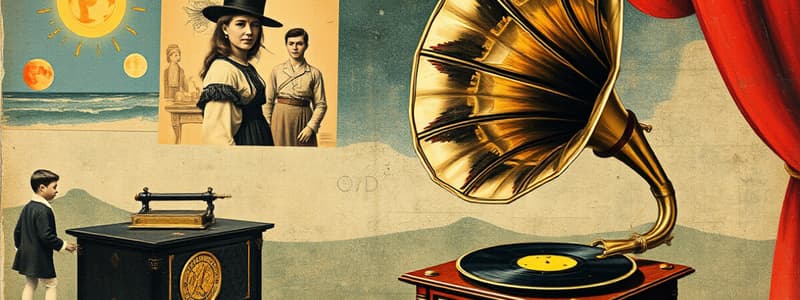Podcast
Questions and Answers
What was the primary invention of the gramophone and its impact on society?
What was the primary invention of the gramophone and its impact on society?
- It allowed both middle and lower classes to access recorded concerts at a lower cost. (correct)
- It recorded live concerts which were expensive for the general public.
- It was primarily used for educational purposes in schools.
- It was developed specifically for the elite class to enjoy music.
In which year was the first commercial radio broadcast made?
In which year was the first commercial radio broadcast made?
- 1930
- 1905
- 1920 (correct)
- 1910
What characterizes impressionist music?
What characterizes impressionist music?
- Bold, clear melodies with minimal harmony.
- Refinement, delicacy, and a hazy atmosphere. (correct)
- A strict adherence to traditional tonal structure.
- A focus on strong rhythm and dramatic intensity.
Which piece is considered one of Claude Debussy's notable works?
Which piece is considered one of Claude Debussy's notable works?
What notable achievement did Maurice Ravel accomplish in 1889?
What notable achievement did Maurice Ravel accomplish in 1889?
Which modernist movement is characterized by expressing strong emotions such as anxiety and anger?
Which modernist movement is characterized by expressing strong emotions such as anxiety and anger?
What method did Arnold Schoenberg develop in music composition?
What method did Arnold Schoenberg develop in music composition?
What distinctive vocal style is employed in Pierrot Lunaire?
What distinctive vocal style is employed in Pierrot Lunaire?
Study Notes
Gramaphone and Radio
- Gramaphone invented in 1890, making recorded music accessible to both middle and lower classes.
- First commercial radio broadcast occurred in 1920, revolutionizing mass communication.
Impressionism in Art and Music
- Impressionism, a painting movement that emerged in France during the 1860s, emphasizes the shifting effects of color and light.
- Impressionist music is characterized by refinement, delicacy, and vagueness, creating a hazy atmosphere with a dreamlike quality.
Notable Works in Impressionism
- "At the Races" created between 1877-1880 exemplifies the movement's style.
- Key music compositions include Debussy's "Nocturne" (1892) and "La Mer" (1905), and Ravel's "Bolero."
Dr. Antonio Molina
- Renowned figure from the Philippines contributing to impressionist music.
Claude Debussy
- Born on August 22, 1862, in France to Manuel-Achille Debussy and Victorine Manoury.
- Began formal music education at age 10 at Paris Conservatoire; first public exposure to music occurred in 1870-1871 during a visit to Cannes.
- Debussy studied under Jean Francois at age 10 and won the Prix de Rome in 1884 for "The Prodigal Child."
- Renowned works include "Prelude to the Afternoon of a Faun" (1892), "Claire de Lune" (1890), and "Engulfed Cathedral" (1910).
Maurice Ravel
- Born on March 7, 1875, in Ciboure, France, to Marie Delourat and Joseph Ravel; family moved to Paris shortly after his baptism.
- Began piano lessons at age 7 with Henry Ghys, who recognized his musical intelligence.
- Ravel’s first public performance was on June 2, 1889, followed by admission to the conservatoire in November 1889.
- Famous for compositions such as "La Valse," "Miroirs," and "Ma Mère L'Oie."
Expressionism
- Modernist movement originating in Germany during the 20th century, focusing on strong emotional expression in art and poetry.
- Expressionism in music encompasses feelings such as anxiety and isolation, influencing various composers.
Arnold Schoenberg
- Born in Austria on September 13, 1874, and died in Los Angeles on July 13, 1951.
- Developed a revolutionary method of organizing music based on a twelve-tone scale, abandoning traditional tonality.
- Known for the radical sounds of his compositions and introducing the twelve-semitone technique.
Key Compositions
- Schoenberg’s "Three Piano Pieces" represents his first original composition (1894).
- "Pierrot Lunaire" showcases the Sprechstimme style, which is a blend of singing and speaking.
Studying That Suits You
Use AI to generate personalized quizzes and flashcards to suit your learning preferences.
Description
Explore the fascinating connection between Impressionism in art and music alongside the evolution of early entertainment technologies like the gramophone and radio. This quiz covers key figures, historical milestones, and the cultural impact of these movements from the late 19th to early 20th centuries.





